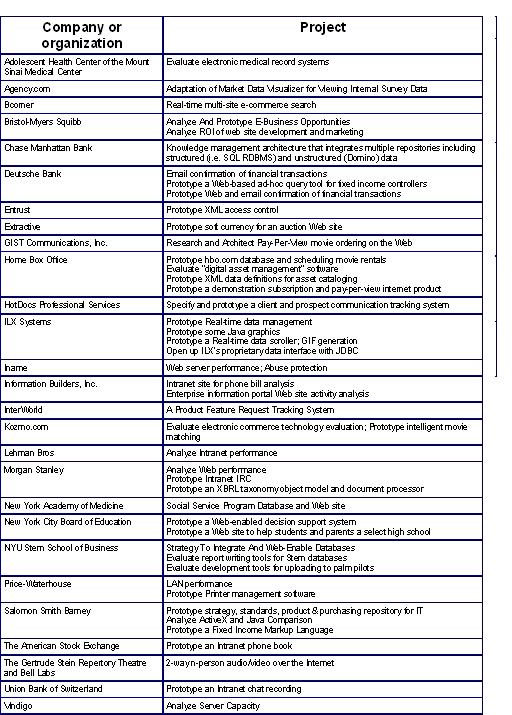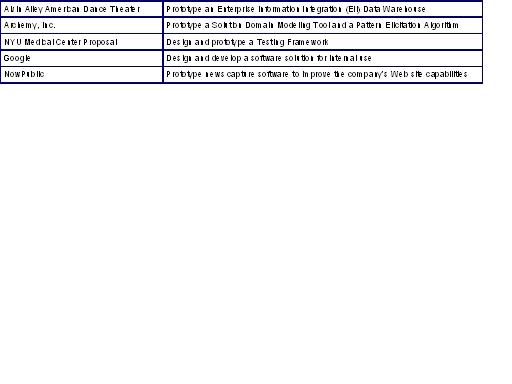Course Description And Syllabus
Information Technology Projects
Summary
NYU's Information Technology Projects course places a team of talented Masters student interns with a company for 3 months. The company helps design their project according to their business needs. The team of 3 to 5 Masters students spends about a quarter to half of their time on the project. The team is jointly supervised by the company and a NYU Professor. A project will accomplish significant IT goals for a company, such as building useful software with advanced technology. NYU's Information Technology Projects course has completed 78 successful projects with 43 New York companies and organizations in the last 9 years. The full list of projects goes all the way back to 1995.
Status
For information about current and future offerings, please see the related Computer Science Department Web pages at:
Educational Goals
The Information Technology Projects course offers students a unique opportunity to apply their learnings about business technology and the entire software development lifecycle, from business needs to deployment. The ITP course amplifies classroom instruction about IT project planning and implementation.
The students are earning a Master of Science in Information Systems degree, which involves 13 courses split between Computer Science and the Stern School of Business. Courant and Stern are world-class educational institutions, highly ranked in evaluations. The course is also open to students earning a Master of Science in Computer Science (http://www.cs.nyu.edu/web/Academic/Graduate/faqnewmscs.html) and project teams are composed by pairing students working on either master degree.
The students are highly talented. They meet high admissions standards, for example GRE Quantitative and Analytical must both be above 85%, at least one above 92%. All of the students have at least a couple of years of work experience. The projects course is taken during one of their last 2 semesters, so they've already completed CS courses including algorithms, networking, and databases and business courses such as technology planning and managing organizations.
Results
Clients of NYU's Information Technology Projects course achieve significant benefits.
• High Quality Project Execution: Using a graduate student team allows companies to accomplish substantial results, with modest effort and a high degree of focus. If the company project is a software development effort, students will analyze the company’s business needs and prototype code with extensive functionality. If the company project is a software purchase evaluation, students will produce a detailed evaluation of the company’s needs, a comprehensive review of suitable commercial products and a recommendation indicating which solution offers the best value. Many other project types are available and can be customized to meet companies’ needs. All intellectual property produced by the project becomes the property of the company.
• Close Evaluation of Potential Future Employees: Many students have been hired by clients upon graduation because of the excellent work performed during a semester project.
• Exposure to New Methods and New Research: Companies can explore new opportunities that their full-time staff does not have time to investigate. In addition, the outside perspective of the NYU team may facilitate exploration of delicate political situations which would create conflict if the company’s full-time staff explored it.
• Direct Involvement of a NYU Professor: You receive hours of a NYU professor’s guidance and advice, spread across the duration of the project.
• Public Relations and Corporate Community Involvement: Through public events like the semester end’s Demo Showcase and various announcements posted by the NYU team running the projects, companies will be able to increase visibility at NYU for future hiring and corporate community relations.
• Chance to Give Back (Optional): Companies may build a relationship with Courant and NYU by contributing to a superb educational program. In this case, companies can feel good about investing in student learning and contributing to higher education. There is however no obligation to contribute monetarily on the part of the companies.
How to participate
Companies interested in being a “client” should speak with the NYU Professor responsible for the ITP project course before the start of the Fall or Spring semester. Companies should begin the discussion by describing a problem they would like solved, and suggesting the approach they would consider for the solution. The ITP Professor will help structure a proposal for a successful project.
As an example, a software development project involves most of the software development lifecycle, including most of these steps:
• determining requirements,
• writing a specification,
• designing an architecture, and
• implementing a prototype
• etc.
The project would employ broadly available technology that the students find interesting and understand, such as databases, the Web, jsp, asp, Java, C++, XML, etc.
The ITP course favor 'experimental' projects, which are not on a company’s 'critical path'. ITP students excel at investigating new technologies or methodologies. Other characteristics that increase the chance of a project's success include:
• well defined goals
• convenient interaction with a small number (5 or fewer) people in the participating company
• a location near NYU, or availability via phone conferences with the company’s responsible staff at least once a week
The ITP Professor will help scope a project with achievable goals.
A software purchase evaluation project can involve any kind of business need and many other project types qualify as part of this course to meet a company’s needs.
A senior person in an organization with the appropriate authority must authorize a company’s participation in a project. To participate in a project, the company must assign a 'project manager' who will provide weekly guidance to the students with respect to the company’s objectives and help them obtain the resources they require. The 'project manager' should expect to spend no more than half a day a week on the project. Typically, they greatly enjoy the experience.
Assuming a suitable project can be identified, the Professor will write a project proposal like the following. Once the company approve the description, it can be circulated to students.
Morgan Stanley
Company Description
Morgan Stanley has earned a worldwide reputation for excellence in financial advice and market execution. The 58,000 members of Morgan Stanley in 28 countries connect people, ideas and capital to help our clients achieve their financial aspirations.
Proposal: XBRL taxonomy object model and document processor
Businesses and governments are making a massive global efforts to standardize the organization, definition and presentation of financial information. The information ranges broadly across many industries and many types of information. Technically, the extensible business reporting language (XBRL; see WWW.XBRL.ORG) is being built to encode this standardization. XBRL is an electronic format for simplifying the flow of financial statements, performance reports, accounting records, and other financial information between software programs. XBRL is based on XML. Two hundred corporations, including Morgan Stanley, are involved in the effort.
XBRL is quite complex because the information it must represent is complex. Consider, for example, the complexities across the multiple dimensions: industries, data types, corporate departments, nations, and languages.
Analogous with XML schemas, the structure of an XBRL document is described by a schema or "taxonomy" definition. Programmers write application that read, analyze, process and output XBRL documents. The development community sorely needs an object model that describes the structure of XBRL taxonomies. Given a taxonomy object model (TOM) a programmer could easily write an XBRL document processing application that could read a taxonomy and read, process or write XBRL documents.
The goals of this project are to:
• Write, in Java, an open-source XBRL taxonomy object model
• Develop, in Java, if time allows, a simple XBRL document processing application
This project will require extensive expertise on XML (which can be obtained during the project) and involve extensive study of the XBRL architecture and specification. This is a significant opportunity to be one of the first 100 people in the world be become expert in this new and important technology.
Intern Address:
1585 Broadway, at 48th
Company Web site
www.morganstanley.com
Project manager
Junior manager or non-manager
Resources that will be made available to students:
• Access to any sample data
• Code and information
• Temporary use of computers
NYU semesters start in early September and mid January. At the beginning of the semester, the ITP Professor staffs projects. (In a given semester 3 to 5 projects will be conducted.) In class, he describes all the proposed projects to the students. Students indicate their interest level for each project. The ITP Professor allocates students to projects. It is important for each student to be placed on a project they find interesting. Therefore, the ITP Professor staffs projects by balancing student interest and the need to provide an appropriate set of skills. If a company proposes a project, it will probably be staffed, but a project may not be staffed if students do not find it interesting or cannot supply the right set of skills.
Project Execution
The ITP Professor and his/her students devote considerable effort and intelligence to company projects. The course is tightly scheduled to accomplish as much as possible during the 14 weeks of an NYU semester. This helps train the students to prosecute IT projects efficiently. Projects executed by a student team are reviewed on a weekly basis by other students working on different projects in the same class and their overall input is used to improve the project deliverables. Weekly meeting minutes are compiled by the project team and become part of the overall set of project deliverables. Three meetings and a show structure the semester (the 'purpose' column in the table below describes just software development projects for illustration purpose):


